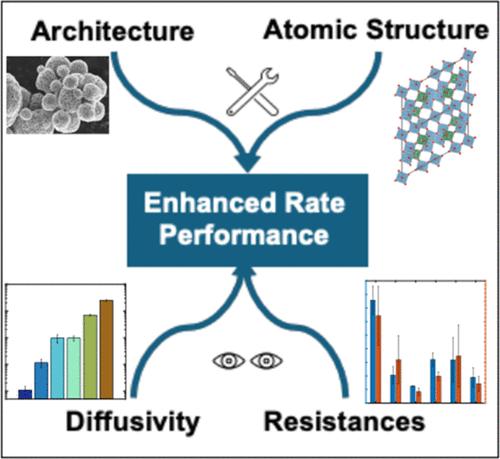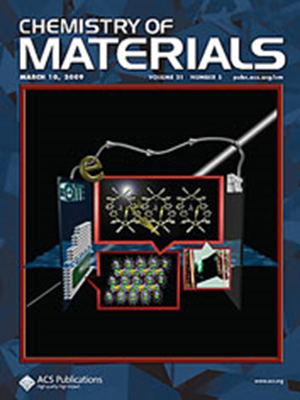Tailored TiNb2O7 Particle Size, Defects, and Crystallinity Accelerate Lithiation
IF 7
2区 材料科学
Q2 CHEMISTRY, PHYSICAL
引用次数: 0
Abstract
TiNb2O7 (TNO) is a promising anode material for durable, fast-charging lithium-ion batteries that combine fast lithium diffusion with minimal lithiation strain based on a Wadsley–Roth crystal structure. Battery performance depends on a convolution of defect-sensitive material properties (lithium diffusivity and electrical resistivity) in conjunction with the architecture (feature size, porosity, and charge-transfer surface). All of these attributes connect to synthetic conditions where there is an opportunity to improve performance by understanding the interplay of changes during crystallization. Nanostructured TNO was prepared via spray drying, where variable crystallization temperature simultaneously influenced crystal structure/defects while coarsening the architecture. Comprehensive X-ray analysis (WAXS, SAXS, and XRD) and microscopy (SEM) characterized the crystallization and coarsening progress. The galvanostatic lithiation capacities (700–1100 °C) were similar at 0.1C (∼300 mAh/g); however, sample TNO-800 exhibited the highest capacity at 5C (260 ± 3 mAh/g). Intermittent current interruption (ICI) analysis revealed increasing diffusivity with calcination temperature and a nonmonotonic trend in cell resistance, minimized for TNO-800. Detailed X-ray near-edge structure (XANES), extended X-ray absorption fine structure (EXAFS), and Rietveld analyses identified that crystallization led to progressive point/extended defect elimination and increasing octahedral distortion. With cell resistance including both electrical resistance and charge-transfer resistance, this overall trend reflects competition of generally improving electronic properties with calcination temperature against the coarsening architecture that progressively increases the charge-transfer resistance. The optimal TNO-800 exhibited a remarkable 10C capacity of 233 ± 1 mAh/g, which compares favorably with leading TNO precedents. This study highlights the complex convolution of atomic structure and architecture changes that occur during crystallization, which may advance other known battery materials.

定制的TiNb2O7颗粒尺寸、缺陷和结晶度加速了锂化
TiNb2O7 (TNO)是一种很有前途的阳极材料,用于耐用、快速充电的锂离子电池,它结合了基于Wadsley-Roth晶体结构的快速锂扩散和最小的锂化应变。电池性能取决于缺陷敏感材料特性(锂的扩散率和电阻率)与结构(特征尺寸、孔隙率和电荷转移表面)的卷积。所有这些属性都与合成条件相关联,通过了解结晶过程中变化的相互作用,有机会提高性能。采用喷雾干燥法制备了纳米结构的TNO,不同的结晶温度在使结构粗化的同时影响了晶体结构/缺陷。综合x射线分析(WAXS, SAXS和XRD)和显微镜(SEM)表征了结晶和粗化过程。在0.1C (~ 300 mAh/g)时,恒流锂化容量(700-1100°C)相似;而样品TNO-800在5C(260±3 mAh/g)时的容量最高。间歇电流中断(ICI)分析显示,随着煅烧温度的升高,扩散系数增加,电池电阻呈非单调趋势,TNO-800最小。详细的x射线近边缘结构(XANES)、扩展的x射线吸收精细结构(EXAFS)和Rietveld分析发现,结晶导致渐进的点/扩展缺陷消除和增加的八面体畸变。由于电池电阻包括电阻和电荷转移电阻,这一总体趋势反映了随着煅烧温度普遍提高的电子性能与逐渐增加电荷转移电阻的粗化结构的竞争。最佳的TNO-800在10C时的容量为233±1 mAh/g,与领先的TNO相比具有优势。这项研究强调了原子结构的复杂卷积和结晶过程中发生的结构变化,这可能会推动其他已知电池材料的发展。
本文章由计算机程序翻译,如有差异,请以英文原文为准。
求助全文
约1分钟内获得全文
求助全文
来源期刊

Chemistry of Materials
工程技术-材料科学:综合
CiteScore
14.10
自引率
5.80%
发文量
929
审稿时长
1.5 months
期刊介绍:
The journal Chemistry of Materials focuses on publishing original research at the intersection of materials science and chemistry. The studies published in the journal involve chemistry as a prominent component and explore topics such as the design, synthesis, characterization, processing, understanding, and application of functional or potentially functional materials. The journal covers various areas of interest, including inorganic and organic solid-state chemistry, nanomaterials, biomaterials, thin films and polymers, and composite/hybrid materials. The journal particularly seeks papers that highlight the creation or development of innovative materials with novel optical, electrical, magnetic, catalytic, or mechanical properties. It is essential that manuscripts on these topics have a primary focus on the chemistry of materials and represent a significant advancement compared to prior research. Before external reviews are sought, submitted manuscripts undergo a review process by a minimum of two editors to ensure their appropriateness for the journal and the presence of sufficient evidence of a significant advance that will be of broad interest to the materials chemistry community.
 求助内容:
求助内容: 应助结果提醒方式:
应助结果提醒方式:


